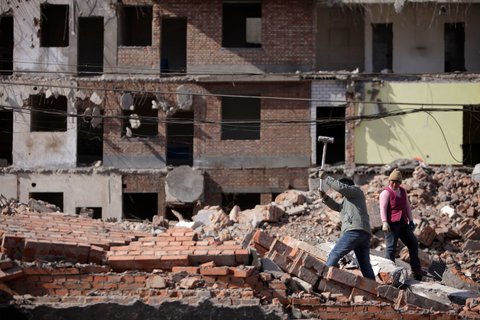Motivations come in all shapes and sizes. When times are rough, intensity and aggression can be used as a quick switch to get going again. It’s easy to turn to these emotions/ideas at times like these. We’ve all felt them to a certain extent at some point.
Both words echo similar meanings, but in certain cases they cannot be further from the same.
Aggression, in its purest form, is short-lived. It is a destructive force that will run out eventually. It can rely on certain emotions (anger/hatred) that can be often misdirected, under the purpose of some “greater good.”
Simply stated, maintaining a high level of aggression to accomplish a task is not sustainable. If your emotions were an engine, could it really afford to run at full speed every minute of every day?
Consider a demolition site. There is a wall that needs to go down (Berlin and Pink Floyd aside). We have two options: blow it up in one fell swoop with dynamite, or we pick up a sledgehammer and chip away.
It seems reasonable to side with dynamite. Who doesn’t enjoy a good explosion from time to time? But if I had more walls than I had dynamite, I’m setting myself up for doing more work than I really should. What if the dynamite isn’t enough to tear down that wall Mr. Gorbachev? What if the dynamite is a dud? Now I’ve suddenly given myself some bigger issues. The only plan I had hasn’t worked and I’ve compromised everything around me.
If I pick up the sledgehammer, I can be a bit more methodical with my work. If I know the design, I can start and end my work in the most efficient way possible. Every single strike has intent. Of course it only works with plenty of energy behind it, but at least each swing I’m taking counts for something.
Approaching situations or events with dynamite instead of a sledgehammer in our hands can make all of the difference in the world. The dynamite will only last for so long; it’s a quick, concentrated and violent effort at addressing the task. Anger, hatred, spitefulness, can all perhaps fuel the aggression we use to accomplish something. But for how long? Our dynamite will run out eventually, and even if we managed to tear down every wall before, we just now have to start to learn how to use the sledgehammer.
The sledgehammer can be our saving grace. Yes it will be tiresome, require more attention, and no we won’t bear witness to things that go boom-boom. What we will see however, is that we can have a better say in what each swing will accomplish. We can persevere, adapt, manipulate, and be in better control of the outcome instead of leaving it to chance that one explosion will do the trick. Intensity can be the purpose and drive behind every action that can go far beyond simple emotions like anger.
The long and winding road leads to this: aggression can work, but not for long. Managing intensity can accomplish the same task, and be better sustained.
Speaking from personal experience, living life with aggressive intentions produces more harm than good. It isn’t long before you take on self-destructive tendencies in blind fury; you forget why you were approaching everything that way in the first place. I can control intensity. I can control intention. I can control purpose. This (as of now) has been much more efficient and fruitful.
All of this isn’t to say that aggression should be completely avoided. Sometimes it is definitely needed. As will be explored later, it may be necessary to have that occur in order to get somewhere. But for now, all I can say is this: when approaching a wall, stop to think, does this call for dynamite or a sledgehammer?
(DISCLAIMER: I have never been an enthusiast/user of explosives or have had extensive experience in demolition. These images come from my twisted and sardonic mind to be taken with multiple grains of salt. Any invitation to an enlightening demolition session will be gladly received.)
Photo cred: http://sinosphere.blogs.nytimes.com/2013/10/20/chinas-mountains-of-construction-rubble/?_r=0

Leave a comment